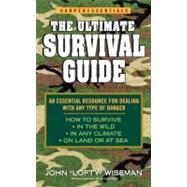
The New copy of this book will include any supplemental materials advertised. Please check the title of the book to determine if it should include any access cards, study guides, lab manuals, CDs, etc.
The Used, Rental and eBook copies of this book are not guaranteed to include any supplemental materials. Typically, only the book itself is included. This is true even if the title states it includes any access cards, study guides, lab manuals, CDs, etc.
Survival is the art of staying alive. Mental attitude is as important as physical endurance and knowledge. You must know how to take everything possible from nature and use it to the full, how to attract attention to yourself so that rescuers may find you, how to make your way across unknown territory back to civilization if there is no hope of rescue, navigating without map or compass. You must know how to maintain a healthy physical condition, or if sick or wounded heal yourself and others. You must be able to maintain your morale and that of others who share your situation.
Any equipment you have must be considered a bonus. Lack of equipment should not mean that you are unequipped, for you will carry skills and experience with you, but those skills and experience must not be allowed to get rusty and you must extend your knowledge all the time.
Think of survival skills as a pyramid, built on the foundation of the will to survive. The next layer of the pyramid is knowledge. It breeds confidence and dispels fears. The third layer is training: mastering skills and maintainingthem. To cap the pyramid, add your kit. Combine the instinct for survival with knowledge, training and kit and you will be ready for anything.BE PREPARED
The Boy Scouts' motto is the right one. Make sure you are physically and mentally prepared before you set out, and pack the appropriate gear for what you plan to do.
CHECK LIST
Before any journey or expedition ask yourself:
HEALTH CHECKS
Have thorough medical and dental check-ups and ensure that you have all the necessary injections for the territories through which you intend to travel.
Park a medical kit to cover all your likely needs and those of each member of your group.
GROUP EXPEDITIONS
Consider the ability of each member to deal with the challenges ahead: it may be necessary to drop unfit candidates. Hold frequent meetings to discuss plans and responsibilities. Nominate a medic, cook, mechanic, driver, navigator, etc. Ensure everyone is familiar with the equipment and that you carry spares.
RESEARCH
The more detailed your knowledge of the place and people, the better your chances. Study your maps carefully, gain as much knowledge of the terrain as possible: climate; weather conditions; river directions and speed offlow; how high are the mountains/hills; what kind of vegetation/animal life can you expect?
PLANNING
Divide the project into phases: entry phase, objective and recovery. Clearly state the aim of each phase and work out a time scale. Plan for emergency procedures such as vehicle breakdown, illness and casualty evacuation.
Allow plenty of time when estimating the rate of progress. Pressure to keep to an over-ambitious schedule leads to exhaustion and errors of judgment.
The need to replenish water supplies from local sources will be a major factor in determining your route.
Make sure someone knows where you are planning to go and your times of departure and expected arrival. Keep them informed at prearranged stages so that failure to contact will set alarm bells ringing. Boats and aircraft are strictly controlled in this respect. If you are hiking in the hills inform the police and local mountain rescue center of your proposed plan.
Contingency plans
Be prepared in case anything goes wrong. What will you do if a vehicle breaks down, or if weather conditions prove more severe than anticipated? i in a party, how will you regroup if separated? What happens if someone falls ill?
EQUIPMENT
Clothes should be well-fitting but not restrictive, giving protection from cold and rain while keeping the body ventilated. Carry waterproofs, a change of clothes and extra warm garments. Layer in cold climates. Synthetics such as GoretexTM and fleece are versatile and useful. Wool is excellent in cold and wet climates, while cotton works well in the tropics.
The Ultimate Survival Guide. Copyright © by John Wiseman. Reprinted by permission of HarperCollins Publishers, Inc. All rights reserved. Available now wherever books are sold.
Excerpted from The Ultimate Survival Guide by John Wiseman
All rights reserved by the original copyright owners. Excerpts are provided for display purposes only and may not be reproduced, reprinted or distributed without the written permission of the publisher.